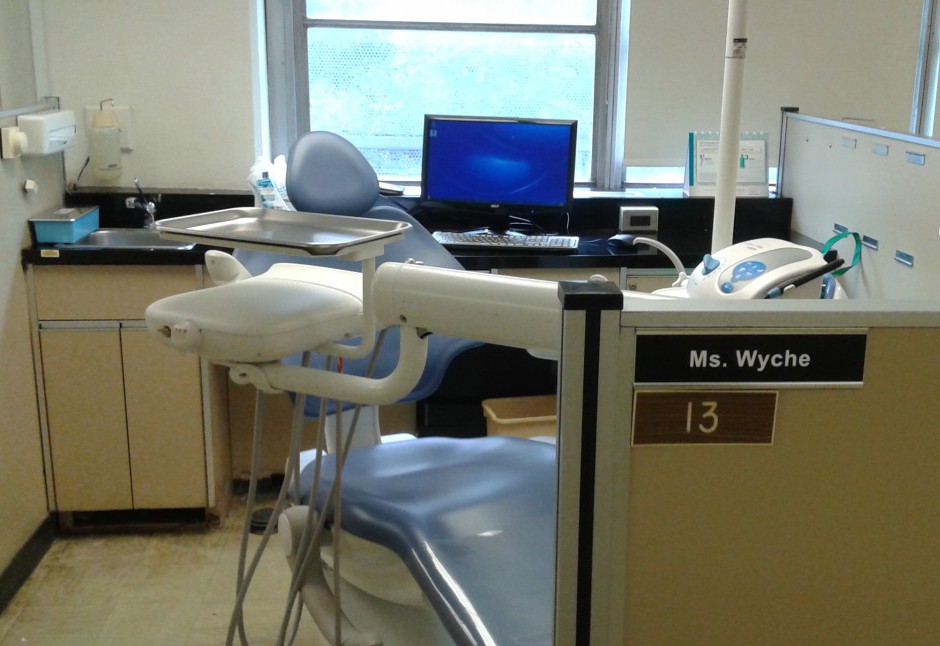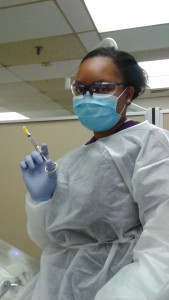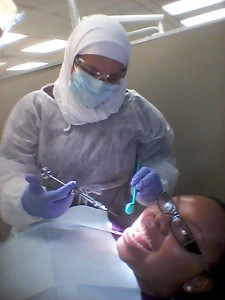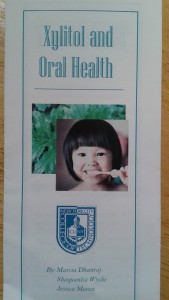Shaquantia Wyche
Bio 490
Dr. Cervino
The Links between Periodontal Disease and Diabetes
and How is the Healing Time of Patients with Diabetes Mellitus Effected By its Presence?
Abstract
Periodontal conditions such as gingivitis and periodontitis by means of the bacterium P.gingivalis have been proven to cause a delay in healing time of diabetic patients. Using a study on mice, P.gingivalis caused a longer expression of cytokines. Other factors such as smoking, glycemic control, and behavioral aspects are considered and shown to have an affect on the recovery of diabetic patients with these periodontal conditions.
Introduction
This research aims to investigate the links between periodontal disease and the healing time of diabetic patients, who are plagued by both pathologies. Diabetes mellitus is a clinical and genetic group of disorders that are characterized by “abnormally” high glucose levels in a subject. Diabetes comes in many forms; these forms are types 1, 2 and gestational diabetes (Sattley, M, 1996; Mealey, B., Ocampo, G. 2006).
Diabetes mellitus is a disease first discovered by unconventional methods by Thomas Willis and was described in his book Pharmaceutice Rationalis (Uston, C, 2005). Type 1 diabetes along with type 2, though, was discovered by Roger Hinsworth (Sattley, M, 1996). Type 1 diabetes is characterized by the result of cellular-mediated immune β-cell destruction which will then result in the loss of insulin secretion in the body (Mealey, B., Ocampo, G. 2006). Insulin, which was discovered by Sir Frederick Banting, is crucial for the body to help uptake glucose that will thus be used for things such as glycolysis, and other mechanisms in the body (Maclean’s , 2000; Sattley, M, 1996). This type of diabetes is most common in children and teens and requires insulin shots to survive. Type 2 diabetes is not dependent on insulin for survival, but resistance to insulin is present which changes the use of insulin secretions at its target cells. This type of diabetes is present in 90-95% of diabetes cases. Lastly, gestational diabetes is characterized by the intolerance to glucose and is first recognized during pregnancy (Mealey, B., Ocampo, G. 2006). One known fact about diabetics is that they have impaired healing time to wounds and exaggerated monocyte response to dental plaque antigens (Pihlstrom et al. 2005). So, since this is the case, I wanted to understand what exactly causes periodontal disease and how the periodontal status of a patient with diabetes effects his/her healing time.
Periodontal disease is a progressive infectious disease that causes inflammation to gums and eventually causing destruction to alveolar bone and loss of the soft tissue that surrounds teeth (Keles, G.C et al, 2007). Periodontal disease is also one of the major causes of tooth loss (Eke, 2005). The mildest form of periodontal disease is gingivitis. Gingivitis is defined as Inflammation and swelling of the gums, which can be reversed by professional treatment and good oral hygiene (Simon, N, 1999). Another form of periodontal disease is periodontitis. Periodontitis is an inflammation of the supporting tissue surrounding teeth caused by anaerobic bacteria and in the diseased state, supporting collagen of the periodontal tissue is destroyed and the alveolar bones begin to dissolve (Löe, H, 1986; Pattnaik, S et al, 2007).
There are several factors that either diabetes or periodontal disease has on the other disease. One factor that periodontal disease has on diabetics is that it alters glycemic control. The degree of glycemic control is an important variable in the relationship between diabetes and periodontal disease, with a higher prevalence and severity of gingival inflammation and periodontal destruction being seen in those with poor control (Mealey, B., Ocampo, G. 2006). Another factor that periodontal disease has is the presence of micro organisms, such as P. gingivalis, which produce toxic products and in turn cause a series of processes that leads to tissue damage (Cutando et el. 2003). Such factors as smoking (Furukawa,M. 2008), age, race, education, and health coverage are also considered (Eke et al. 2005). Lastly, preventative measures, such as simple yearly visits to the dentist and cooperation between dentist and primary care physicians can keep diabetes and periodontal disease under control (Owens, M. et al. 2008).
Through multiple studies, the link between diabetes and periodontal disease has been proven. But in this paper the highlight will be only on two that I think ties in the idea of diabetes, periodontal disease and the bacterial culprit P. gingivalis. The two papers that will be considered are Diabetes Prolongs the Inflammatory Response to a Bacterial Stimulus Through Cytokine Dysregulation by Naguib et al, and Relationships Between Salivary Melatonin Levels and Periodonal Status in Diabetic Patients by Cutando et al.
Results
In the first paper, Diabetes Prolongs the Inflammatory Response to a Bacterial Stimulus Through Cytokine Dysregulation by Naguib et al, the correlation between the gram-negative bacteria P.gingivalis and prolonged inflammatory response in diabetics was shown.
(Figure 1)
In the above figure samples A-D are results from the scalp of diabetic (db/db) mice whose scalps were inoculated with the bacteria P.gingivalis. Figure samples E-H are results from the scalp of control (db/+) mice whose scalps were inoculated with the bacteria P.gingivalis. These samples were taken three days after the initial inoculation of the bacteria.
As you can tell from samples A-D, the diabetic samples, after three days there is so much inflammation, even in the periphery region. Conversely, samples E-H shows significantly less inflammation, and almost no sign of inflammation in sample H. Indeed, P.gingivalis is responsible for the prolonged inflammatory response in diabetic mice.
What about cytokine expression as mentioned in the title of the paper being discussed here? Well, cytokine expression was measured by RNase protection assay at the inoculation site. The TNF (tumor nucrosis factor) expression was similar in both the diabetic ice and the control mice on day one. On day three though, the TNF expression of the diabetic mice was significantly more prominent than in the control mice (Figure 2).
(Figure 2)
Naguib, Ghada, et al. “Diabetes Prolongs the Inflammatory Response to a Bacterial Stimulus Through Cytokine Dysregulation.” Journal of Investigative Dermatology 123.1 (2004): 87-92. Academic Search Premier.
The second paper, Relationships Between Salivary Melatonin Levels and Periodonal Status in Diabetic Patients by Cutando et al, the relationship between melatonin and periodontal status was explored, along with suggested healing time for type 1 diabetics. In the following table a significant piece of information is displayed, in that diabetic patients are shown as having lower levels of plasma and salivary melatonin compared to their peers who don’t have diabetes. In table 1, plasma and saliva melatonin along with IL-2 levels are compared as per each type of diabetes. In figure 1, we see that IL-2 levels are studied in terms of each type of diabetes. The results show that type 2 diabetics have higher levels of both plasma and salivary melatonin. As per IL-2, this is not dependent on the type of diabetes.
Table 1. Comparison between the studied variables in controls and diabetic patients
Data are expressed as mean } S.D. Age is expressed in years and melatonin and IL-2 in pg/mL. n, number of cases. **P < 0.001 versus control. PM, plasma melatonin; SM, saliva melatonin.
| Variables |
Control (n = 20) |
Diabetic (n = 43) |
| Age |
48.9 ± 10.3
|
53.8 ± 12.4
|
| PM |
14.91 ± 4.75
|
8.98 ± 7.14**
|
| SM |
4.35 ± 0.98
|
2.70 ± 2.04**
|
| SM/PM |
0.30 ± 0.06
|
0.31 ± 0.07
|
| IL-2 |
4.00 ± 0.99
|
4.10 ± 2.07
|
Cutando, Antonio, et al. “Relationship between salivary melatonin levels and periodontal status in diabetic patients.” Journal of Pineal Research 35.4 (2003): 239-244. Academic Search Premier.
Discussion
Through two in vivo studies, the link between diabetes and periodontal disease was proven to be the bacteria P.gingivalis. The gram negative anaerobic bacteria found deep within the pockets of the periodontium. It was interesting to see the results first hand knowing that diabetics are more susceptible to gram negative infections (Naguib et al, 2004).
As for the assessment of the inflammatory response in live mammals, the results proved that P.gingivalis indeed has a longer inflammatory response in diabetic subjects. The most significant finding was on the third day of the study, diabetic subjects had a longer and persistent cytokine reaction, by the presence of TNF (tumor nucrosis factor) compared to the control subjects.
So, what does this mean in terms of helping a diabetic with periodontal disease? What about some way blocking those cytokines which cause inflammation? Studies have shown that the inflammatory response can be reversed if treated with TNF inhibitors (Naguib et al, 2004). Although this success is on a small scale, this can soon be the future of helping diabetics especially type 1 diabetics, on their way to a speedy recovery.
As far as periodontal status and melatonin levels the correlation was made clear. Melatonin, which is a free radical “scavenger” and also an anti-inflammatory and bone repairer, balances the stress caused to the periodontium by P.gingivalis (Cutando et al, 2003). Diabetic patients had lower levels of melatonin than their healthy counterparts, but type 1 diabetics has even lower levels when comparing the two types of this disease. Interleukine-2 was also looked at in this study. Interleukins are produced when there is some type of antigenic stimulus. Because there was no change in the values of this along with a much lower melatonin levels shows that diabetics have slower healing times.
So what must diabetics do, knowing that their healing times are not as fast as their healthy counterparts, if they have periodontal disease? One, they should watch their glycemic controls because poor control equals higher prevalence and severity of gingival inflammation and periodontal destruction (Mealey, B., Ocampo, G. 2006). Second, live a healthy lifestyle free of smoking because smoking interferes with healing, making smokers more likely not respond to treatment and to lose teeth. In conjunction with that fact, It’s sobering for them to know that an estimated 55 percent of periodontitis cases in the United States occurred among current smokers and 22 percent among former smokers (Nation’s Health, 2000). Lastly, but definitely not least, diabetics need to have regular dental visits along with good oral hygiene. Certain behavioral risk factors such as age, ethnicity, education, income, and even the number of teeth already lost deeply affects the outcome of a patient visiting the dentist or not (Eke, P.I, 2005). Overall, diabetics with periodontal disease don’t have to suffer as much if they take these precautions. Hopefully, findings such as the ones highlighted in this paper will be a motivation factor.
Materials and Methods
In the Diabetes Prolongs the Inflammatory Response to a Bacterial Stimulus Through Cytokine Dysregulation paper by Naguib et al, the study was done on diabetic mice (Db/Db) and on control mice (Db/+). The diabetic mice developed diabetes at weeks 6-8 and by their 10th or 11th week the experiment was actually carried out. For the experiment, the mice were inoculated with P.gingivalis in their scalps subcutaneously.
For histological data, five micron sections were used. These sections were prepared by being stained with hematoxylin and eosin. The amount of inflammation was taken in two areas- center and periphery. As for cytokine expression (TNF), the mice scalps were dissected and frozen in liquid nitrogen on days 0, 1 and 3. The total amount of RNA was taken from the frozen scalp tissue and verified by agarose gel electrophoresis. The amount of expression was measured by RNase protection assay. Each value was normalized by glyceraldehydes-3-phosphate dehydrogenase in the same lane as the sample.
In the Relationships Between Salivary Melatonin Levels and Periodonal Status in Diabetic Patients paper by Cutando et al, the experiment was done on 63 live patients. The patients were divided in two groups- control group (healthy patients), and the other group diabetic patients (20 with type 1 diabetes and 23 with type 2 diabetes). For plasma melatonin level determination, blood samples of the patients were taken and then centrifuged at 3000g for 10 minutes, then frozen at -20°C. The plasma was separated and melatonin levels were determined by a commercial RIA. Salivary melatonin levels were determined after patients chewed a piece of paraffin. Saliva was collected after the first 2 minutes of chewing, for 5 minutes (those first 2 minutes of saliva were not used). The saliva melatonin samples were centrifuged, frozen and measured as plasma samples. Plasma IL-2 levels were determined by using an enzyme linked immunosorbent assay.
Works Cited
- Cutando, Antonio, et al. “Relationship between salivary melatonin levels and periodontal status in diabetic patients.” Journal of Pineal Research 35.4 (2003): 239-244. Academic Search Premier. EBSCO. Web. 3 Oct. 2009.
- Eke, P. I., G. O. Thornton-Evans, and G. L. Beckles “Dental Visits Among Dentate Adults with Diabetes — United States, 1999 and 2004.” MMWR: Morbidity & Mortality Weekly Report 54.46 (2005): 1181-1183. Academic Search Premier. EBSCO. Web. 3 Oct. 2009.
- Furukawa, Masakazu “A Study of Influence of Brushing Teeth, Smoking, and Diabetes on Consultation Rate for Periodontal Disease in Japan.” Internet Journal of Health 7.1 (2008): 3. Academic Search Premier. EBSCO. Web. 3 Oct. 2009.
- Keleş, Gonca Çayır, et al. “The Role of Periodontal Disease on Acute Phase Proteins in Patients With Coronary Heart Disease and Diabetes.” Turkish Journal of Medical Sciences 37.1 (2007): 39-44. Academic Search Premier. EBSCO. Web. 3 Oct. 2009.
- Löe, H., et al. “Natural history of periodontal disease in man: Rapid, moderate and no loss of attachment in Sri Lankan laborers 14 to 46 years of age.” Journal of Clinical Periodontology 13.5 (1986): 431-440. Academic Search Premier. EBSCO. Web. 5 Dec. 2009.
- Mealey, B.L, Ocampo, G.L “Diabetes mellitus and Periodonal disease” Periodontal 2000 44 (2006): 127-153. Academic Search Premier. EBSCO. Web. 3 Oct. 2009.
- Naguib, Ghada, et al. “Diabetes Prolongs the Inflammatory Response to a Bacterial Stimulus Through Cytokine Dysregulation.” Journal of Investigative Dermatology 123.1 (2004): 87-92. Academic Search Premier. EBSCO. Web. 11 Dec. 2009.
- Owens, Michelle D., et al. “Women with Diagnosed Diabetes across the Life Stages: Underuse of Recommended Preventive Care Services.” Journal of Women’s Health (15409996) 17.9 (2008): 1415-1423. Academic Search Premier. EBSCO. Web. 3 Oct. 2009.
- Pattnaik, S et al. “Periodontal Muco-Adhesive Formulations for the Treatment of Infectious Periodontal Disease. Current Drug Delivery. 4 (2007). 306-23. Academic Search Premier. EBSCO. Web. 3 Oct. 2009.
- Pihlstrom, B et al. “Periodontal Disease.” The Lancet. 366 (2005). 1809-20. Academic Search Premier. EBSCO. Web. 3 Oct. 2009.
- Sattley, Melissa. “The History of Diabetes.” Diabetes Health.com. 11 (1996). Diabeteshealth.com. Web. 10 Dec. 2009
- Simon, N. “Gorgeous Gums and Why They Matter.” New Choices 39.8 (1999): 82-3. Academic Search Premier. EBSCO. Web. 10 Dec. 2009
- “Sir Frederick Banting. (Cover story).” Maclean’s 113.36 (2000): 30. Academic Search Premier. EBSCO. Web. 10 Dec. 2009
- Uston, Cagatay. “NEUROwords Dr. Thomas Willis’ Famous Eponym: The Circle of Willis.” Journal of the History of the Neurosciences 14.1 (2005): 16-21. Academic Search Premier. EBSCO. Web. 10 Dec. 2009.







